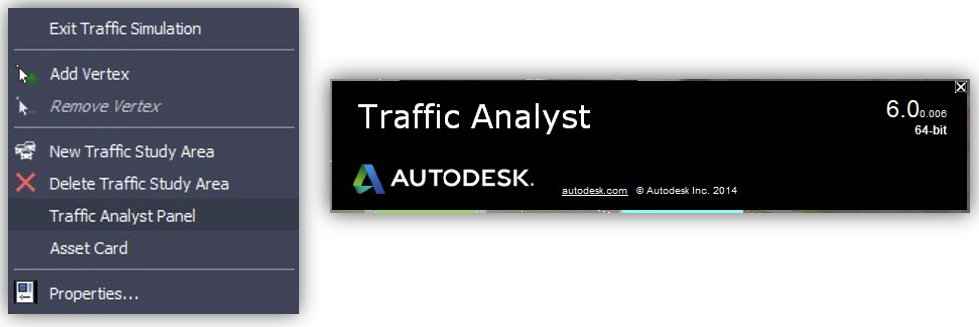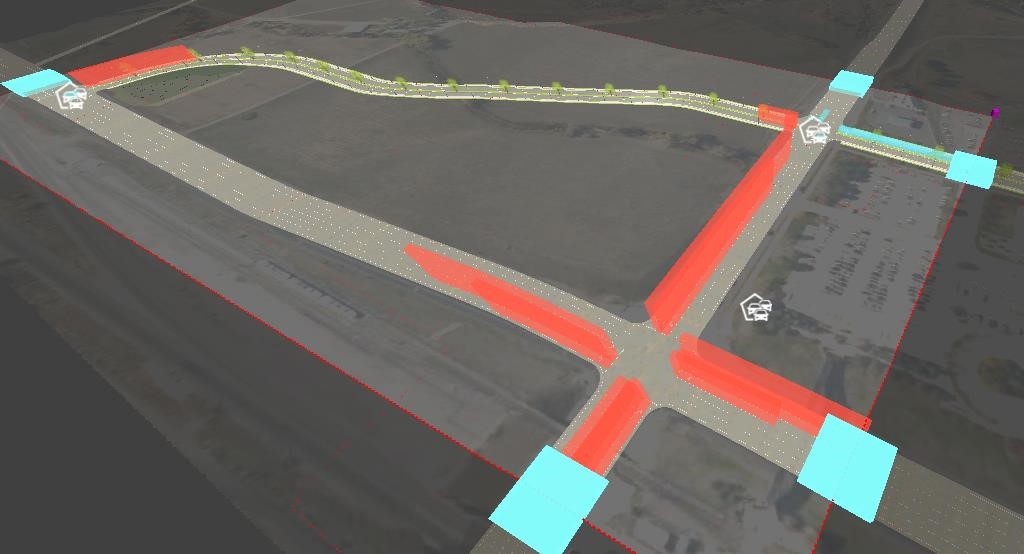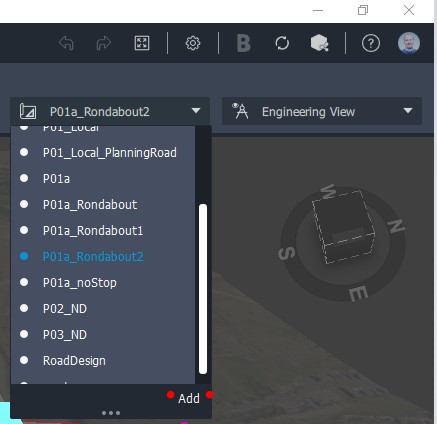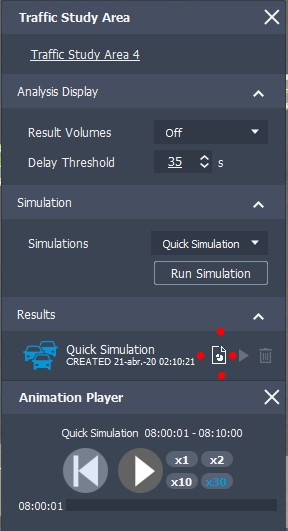& Construction

Integrated BIM tools, including Revit, AutoCAD, and Civil 3D
& Manufacturing

Professional CAD/CAM tools built on Inventor and AutoCAD

Integrated BIM tools, including Revit, AutoCAD, and Civil 3D

Professional CAD/CAM tools built on Inventor and AutoCAD
Transcript
00:01
GOYO GRZESKOW: Hi there.
00:02
In this video, we will discover different types of analysis
00:04
available within InfraWorks are part of the traffic simulation
00:07
one.
00:07
We will learn how to extract helpful data
00:10
or reports crucial for our decision making process.
00:14
This is where we are on the overall view
00:15
of the analysis in civil engineering learning path.
00:20
Let's start analyzing and designing
00:22
the bridge on the PO2 proposal using the Line Girder
00:25
Analysis on how to do structure a bridge design.
00:28
This is an idea of the bridge resting on two piers.
00:31
One with three large columns and the other
00:33
with two small columns.
00:36
On the InfraWorks analysis app, we open the Line Girder
00:39
Analysis tool and then we click on Start to analyze the bridge.
00:45
We can easily display the material quantities
00:48
at different detail level.
00:51
The bridge can be easily exported to Revit
00:54
for further detailing by generating an updatable IMX
00:57
file.
01:00
InfraWorks also allow us to extract a linked Excel file
01:04
that contains the parametric bridge geometry
01:07
and from which we are able to modify our model.
01:11
If we open the Excel file created
01:13
we will see multiple tabs that relate to the different bridge
01:16
parts.
01:17
Note that the blue fields are editable.
01:20
Let's try the functionality by editing the small pier
01:23
to match the large one.
01:25
After completing the edit in Excel remember to save the file
01:28
and within InfraWorks select the option to update the existing
01:31
spreadsheet.
01:34
Notice how the small pier has changed much in the large one.
01:38
Once the line girder analysis has been completed,
01:41
we can see that all the girders or beam are red colored.
01:44
This means that any of them have passed
01:46
these structural requirements of the error codes UK standards.
01:50
We might have sufficient information
01:51
with the results shown within the line girder analysis
01:54
window.
01:54
If that's not the case you can use your cloud credits
01:57
to purchase full girder design recommendation
01:59
for the selected concrete bridge by selecting Get Full Report.
02:07
Let's make the girders this bigger
02:09
and rerun the analysis to check if our amendments have
02:11
positively helped the structural behavior of the bridge.
02:15
When you purchase the full report,
02:18
line girder analysis also generates
02:20
is a full model of your bridge that you can open and work
02:23
within in the standard conversion of Autodesk
02:25
structural bridge design.
02:26
Note that as the girders are increased
02:28
the quantities table reflect the changes accordingly.
02:35
So the reason why this analysis is going so fast
02:38
is because it's accelerated.
02:39
Normally it takes several minutes
02:42
to have the analysis done and download end results.
02:45
As you can see now the beams are colored in different way.
02:48
If you hover over them you will see the general working
02:53
ratio of each beam.
02:56
If we got the full report and we will
02:58
like to know where it's stored within our computer,
02:60
we will need to follow the following path
03:02
after reaching out the folder where our project is store.
03:07
Once there, we will see the structural bridge design
03:09
files on the model and the PDFs on the report folder.
03:15
InfraWorks allows us to optimize our corridors and profiles
03:19
both horizontally and vertically respectively.
03:22
Under the transportation option of the InfraWorks analyze tab,
03:25
you will find both profile and corridor optimization.
03:29
Simply select the component road and click on Optimize.
03:32
We'll receive an email whenever our optimization
03:35
is ready with a full report attached.
03:37
Additionally we have the option to create
03:39
a new proposal that includes a model with changes optimized.
03:43
Besides the optimization reports,
03:45
there are a couple of simple yet reliable tools
03:47
at the end of your finger tips worth to mention
03:49
and able to explore reports.
03:51
One of them is the material quantities.
03:53
You will be able not only to understand lengths, areas
03:56
and volumes of your road components
03:58
but this report also includes the count of 3D models that
04:01
are part of the component road.
04:03
The other one is the earthwork quantities.
04:05
You can fill volumes for an entire component road,
04:08
a specified station ridge, or multiple selected roads.
04:12
After you make changes to a component road,
04:14
InfraWorks updates the earthworks to fill quantity.
04:17
When editing the road you can quickly
04:19
compare fill volumes between edits
04:22
to get closer to balancing the earth
04:23
works towards a net zero volume.
04:27
Another tool able to give valuable insights
04:30
and help us evaluate our designs is the Sight Distance tool.
04:35
This tool will allow us to understand
04:37
the level of visibility going to sections or component roads.
04:41
It takes into account assembly declarations and city furniture
04:45
that could interfere with a vehicle direct visual line.
04:49
It does not work on roundabout.
04:51
In the example we are checking in an intersection that
04:53
has a sight failure for the vehicles turning left
04:57
at the stop contra position.
04:59
In this particular case, the issue
05:00
is related to the elevation of the road intersecting
05:03
the main freeway.
05:05
And it can be easily amended by elevating the last PVI,
05:09
Point of Vertical Intersection.
05:19
And last but not least, the traffic simulation
05:22
reports we can download from InfraWorks using the traffic
05:25
simulation preview window or ask to cart
05:27
once a simulation has been run.
05:29
Under the results section click on the icon
05:31
to the left of the play simulation button.
05:33
It will download reports for cyclist, freight, people,
05:36
public transport, and private vehicles.
05:39
That is the one we are interested in.
05:41
Once in, we'll see multiple summaries
05:43
and under the result vehicle detector
05:45
a particularly interesting outcome,
05:47
the pollution generated.
05:48
CO2, NOx, and PM10.
05:53
Reports for the three main proposals have been generated.
05:56
PO1 A, with have roundabouts, PO2 and PO3.
05:59
Although we feel that the PO3 will be the greenest proposal
06:02
as we observe, the best functional match
06:05
is the PO1 option with roundabout.
06:10
In order to have a big picture and a remarkable justification
06:14
to complete our data driven designs.
06:16
Let's include the pollution results
06:18
coming from the PO1 proposal with signalized intersections.
06:23
Check how the kilograms of CO2 difference.
Video transcript
00:01
GOYO GRZESKOW: Hi there.
00:02
In this video, we will discover different types of analysis
00:04
available within InfraWorks are part of the traffic simulation
00:07
one.
00:07
We will learn how to extract helpful data
00:10
or reports crucial for our decision making process.
00:14
This is where we are on the overall view
00:15
of the analysis in civil engineering learning path.
00:20
Let's start analyzing and designing
00:22
the bridge on the PO2 proposal using the Line Girder
00:25
Analysis on how to do structure a bridge design.
00:28
This is an idea of the bridge resting on two piers.
00:31
One with three large columns and the other
00:33
with two small columns.
00:36
On the InfraWorks analysis app, we open the Line Girder
00:39
Analysis tool and then we click on Start to analyze the bridge.
00:45
We can easily display the material quantities
00:48
at different detail level.
00:51
The bridge can be easily exported to Revit
00:54
for further detailing by generating an updatable IMX
00:57
file.
01:00
InfraWorks also allow us to extract a linked Excel file
01:04
that contains the parametric bridge geometry
01:07
and from which we are able to modify our model.
01:11
If we open the Excel file created
01:13
we will see multiple tabs that relate to the different bridge
01:16
parts.
01:17
Note that the blue fields are editable.
01:20
Let's try the functionality by editing the small pier
01:23
to match the large one.
01:25
After completing the edit in Excel remember to save the file
01:28
and within InfraWorks select the option to update the existing
01:31
spreadsheet.
01:34
Notice how the small pier has changed much in the large one.
01:38
Once the line girder analysis has been completed,
01:41
we can see that all the girders or beam are red colored.
01:44
This means that any of them have passed
01:46
these structural requirements of the error codes UK standards.
01:50
We might have sufficient information
01:51
with the results shown within the line girder analysis
01:54
window.
01:54
If that's not the case you can use your cloud credits
01:57
to purchase full girder design recommendation
01:59
for the selected concrete bridge by selecting Get Full Report.
02:07
Let's make the girders this bigger
02:09
and rerun the analysis to check if our amendments have
02:11
positively helped the structural behavior of the bridge.
02:15
When you purchase the full report,
02:18
line girder analysis also generates
02:20
is a full model of your bridge that you can open and work
02:23
within in the standard conversion of Autodesk
02:25
structural bridge design.
02:26
Note that as the girders are increased
02:28
the quantities table reflect the changes accordingly.
02:35
So the reason why this analysis is going so fast
02:38
is because it's accelerated.
02:39
Normally it takes several minutes
02:42
to have the analysis done and download end results.
02:45
As you can see now the beams are colored in different way.
02:48
If you hover over them you will see the general working
02:53
ratio of each beam.
02:56
If we got the full report and we will
02:58
like to know where it's stored within our computer,
02:60
we will need to follow the following path
03:02
after reaching out the folder where our project is store.
03:07
Once there, we will see the structural bridge design
03:09
files on the model and the PDFs on the report folder.
03:15
InfraWorks allows us to optimize our corridors and profiles
03:19
both horizontally and vertically respectively.
03:22
Under the transportation option of the InfraWorks analyze tab,
03:25
you will find both profile and corridor optimization.
03:29
Simply select the component road and click on Optimize.
03:32
We'll receive an email whenever our optimization
03:35
is ready with a full report attached.
03:37
Additionally we have the option to create
03:39
a new proposal that includes a model with changes optimized.
03:43
Besides the optimization reports,
03:45
there are a couple of simple yet reliable tools
03:47
at the end of your finger tips worth to mention
03:49
and able to explore reports.
03:51
One of them is the material quantities.
03:53
You will be able not only to understand lengths, areas
03:56
and volumes of your road components
03:58
but this report also includes the count of 3D models that
04:01
are part of the component road.
04:03
The other one is the earthwork quantities.
04:05
You can fill volumes for an entire component road,
04:08
a specified station ridge, or multiple selected roads.
04:12
After you make changes to a component road,
04:14
InfraWorks updates the earthworks to fill quantity.
04:17
When editing the road you can quickly
04:19
compare fill volumes between edits
04:22
to get closer to balancing the earth
04:23
works towards a net zero volume.
04:27
Another tool able to give valuable insights
04:30
and help us evaluate our designs is the Sight Distance tool.
04:35
This tool will allow us to understand
04:37
the level of visibility going to sections or component roads.
04:41
It takes into account assembly declarations and city furniture
04:45
that could interfere with a vehicle direct visual line.
04:49
It does not work on roundabout.
04:51
In the example we are checking in an intersection that
04:53
has a sight failure for the vehicles turning left
04:57
at the stop contra position.
04:59
In this particular case, the issue
05:00
is related to the elevation of the road intersecting
05:03
the main freeway.
05:05
And it can be easily amended by elevating the last PVI,
05:09
Point of Vertical Intersection.
05:19
And last but not least, the traffic simulation
05:22
reports we can download from InfraWorks using the traffic
05:25
simulation preview window or ask to cart
05:27
once a simulation has been run.
05:29
Under the results section click on the icon
05:31
to the left of the play simulation button.
05:33
It will download reports for cyclist, freight, people,
05:36
public transport, and private vehicles.
05:39
That is the one we are interested in.
05:41
Once in, we'll see multiple summaries
05:43
and under the result vehicle detector
05:45
a particularly interesting outcome,
05:47
the pollution generated.
05:48
CO2, NOx, and PM10.
05:53
Reports for the three main proposals have been generated.
05:56
PO1 A, with have roundabouts, PO2 and PO3.
05:59
Although we feel that the PO3 will be the greenest proposal
06:02
as we observe, the best functional match
06:05
is the PO1 option with roundabout.
06:10
In order to have a big picture and a remarkable justification
06:14
to complete our data driven designs.
06:16
Let's include the pollution results
06:18
coming from the PO1 proposal with signalized intersections.
06:23
Check how the kilograms of CO2 difference.





How to buy
Privacy | Do not sell or share my personal information | Cookie preferences | Report noncompliance | Terms of use | Legal | © 2025 Autodesk Inc. All rights reserved
Sign in to start learning
Sign in for unlimited free access to all learning content.Save your progress
Take assessments
Receive personalized recommendations
May we collect and use your data?
Learn more about the Third Party Services we use and our Privacy Statement.May we collect and use your data to tailor your experience?
Explore the benefits of a customized experience by managing your privacy settings for this site or visit our Privacy Statement to learn more about your options.